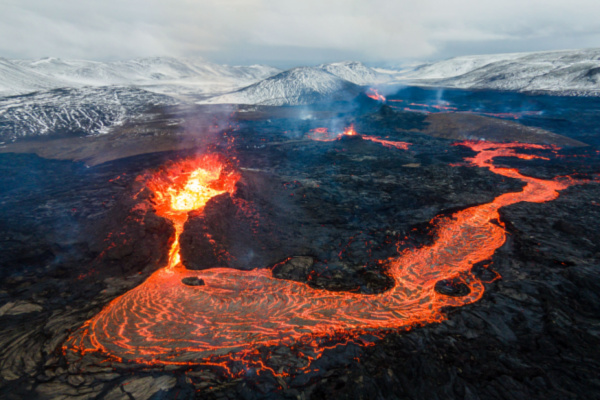Volcanic activity is a fact of life in Iceland. People have learned to live with both its drawbacks and considerable advantages, such as geothermal energy and a dramatic natural environment – and even entertainment.
After months of speculation and weeks of local resident evacuations, on December 18, 2023 a new volcanic eruption started on the Reykjanes peninsula. The fissure eruption started northeast of Grindavík and east of the Blue Lagoon along the Sundhnúkagigar crater row. Here is what makes Iceland’s volcanic activity so unique.
Stuck between a Mid Ocean Ridge and a Hot Spot
Iceland is among the most volcanically active places in the world, with roughly one eruption every five years. Aside from liquid lava, Iceland’s volcanoes eject gas, ash, cinders, and solid rock (like pumice). The biggest rocks are sometimes called “volcanic bombs.” Volcanic eruptions can last from a couple of days to several years.
According to Visit Iceland, this Nordic Island Nation sits on top of the Mid-Atlantic Ridge, a 40.000 km long crack in the ocean floor caused by the separation of the North American and Eurasian tectonic plates. Even today, the country is growing by about 2 cm per year, as it splits wider at the points where the two tectonic plates meet, and new magma fills up the gaps. Accordingly, the western part of Iceland belongs to the North American plate and the eastern region to the Eurasian plate, which means Iceland is split between two continents.
Another key player in Iceland volcanism is a powerful magma plume that creates an upwelling of heat and magma in the mantle under the island and lifts Iceland’s crust above sea level.
There’s a Volcanic Eruption every 4 Years
As a result of being in a unique setting where a continental rift and a magma plume join forces, Iceland is one of Earth’s most volcanically active areas. On average, Iceland experiences a volcanic event every four years. Since the end of the last ice age, about 10.000 years ago, a third of all lava that volcanos have produced on the Earth’s surface has erupted in Iceland. The most significant lava flow in a single eruption on the planet during the Holocene is The great Þjórsá lava that erupted around 8.600 years ago and is estimated to be 26 km3.
Since October 2023 there has been increased seismic activity in the Reykjanes area, which might indicate an upcoming volcanic eruption.
This same geological activity is also responsible for some of the most dramatic features of Icelandic nature. The mountainous landscapes, black lava fields, black sand beaches, geothermal pools and geysers, and even glaciers result from a continuous interplay between volcanic activity and the natural elements.
Types of Volcanos
Of the roughly 130 volcanoes in Iceland, the most common type is the stratovolcano — the classic cone-shaped peak with explosive eruptions that form a crater in the very top (such as Hekla and Katla, on the South Coast). There are also a few dormant shield volcanoes — with low-profile, wide-spreading lava flows; one called Skjaldbreiður is near the Golden Circle. Eruptions from fissure vents — long cracks in the earth’s crust — are also common in Iceland, such as the Holuhraun eruption of 2014 and the destructive Laki eruptions in the 1780s.
Volcanos produce Glaciers, Jokulhlaups, and Sandur Plains
Iceland’s entire surface is made of volcanic rock, most of it basalt — the rock that forms when lava cools. Iceland’s towering cliffs and jagged islands and skerries are all made of basalt. When basalt cools in particular ways, it forms the hexagonal rock columns that you can see at Reynisfjara (on the South Coast) and other places.
New lava is shiny and oily-looking, while old lava loses its gleam. Old lava fields — recognizable by their unique, bumpy appearance — are often covered by a fuzzy layer of Icelandic moss.
At the lake called Mývatn, in northern Iceland, you can see pseudocraters (also called “rootless cones”), which form after lava flows cover a pond or marsh. The water underneath the lava boils and a giant bubble breaks through the lava, leaving a crater-like depression.
It may sound like a contradiction, but it is a fact that volcanos produce glaciers. This is because volcanism builds mountains that reach up to colder levels in the atmosphere that absorb moisture from the air, feeding the glaciers on top.
Heat radiating from the interiors of volcanos melts the ice from below, and when enough water has collected in depressions under the ice to lift the ice cap on top, it bursts out from under the glacier front and creates a flood or “jökulhlaup” on the outwash plain or “sandur” plain” in front. This process is so unique for Iceland that the Icelandic words for the phenomena are recognized as international terms.
Benefits of Volcanos
Icelanders have also reaped the benefits of vast geothermal energy resources – one of the cheapest and cleanest forms of energy in existence. Over 85% of housing in Iceland is heated by natural geothermal heat from hot springs common in most parts of Iceland. In addition, meltwater from glaciers provides the country with a potential source of hydroelectric power. All this clean energy has made Iceland one of the least polluted countries in the world.
The interplay between volcanos and glaciers results in enormous productivity of volcanic ash, which fertilizes the soil and creates beautiful black sand beaches.
Not to mention the entertaining value of “tourist eruptions”– and perhaps, Icelandic-volcano-related Hollywood movie songs.
—
Photo Credit: ImageBank4u / Shutterstock.com
